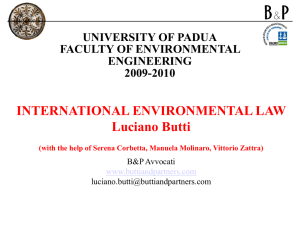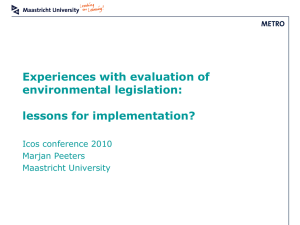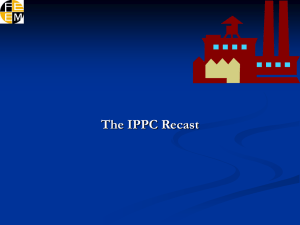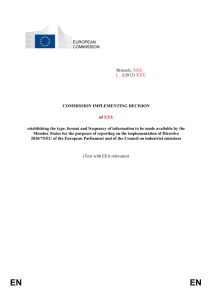COM COM(2007)
advertisement
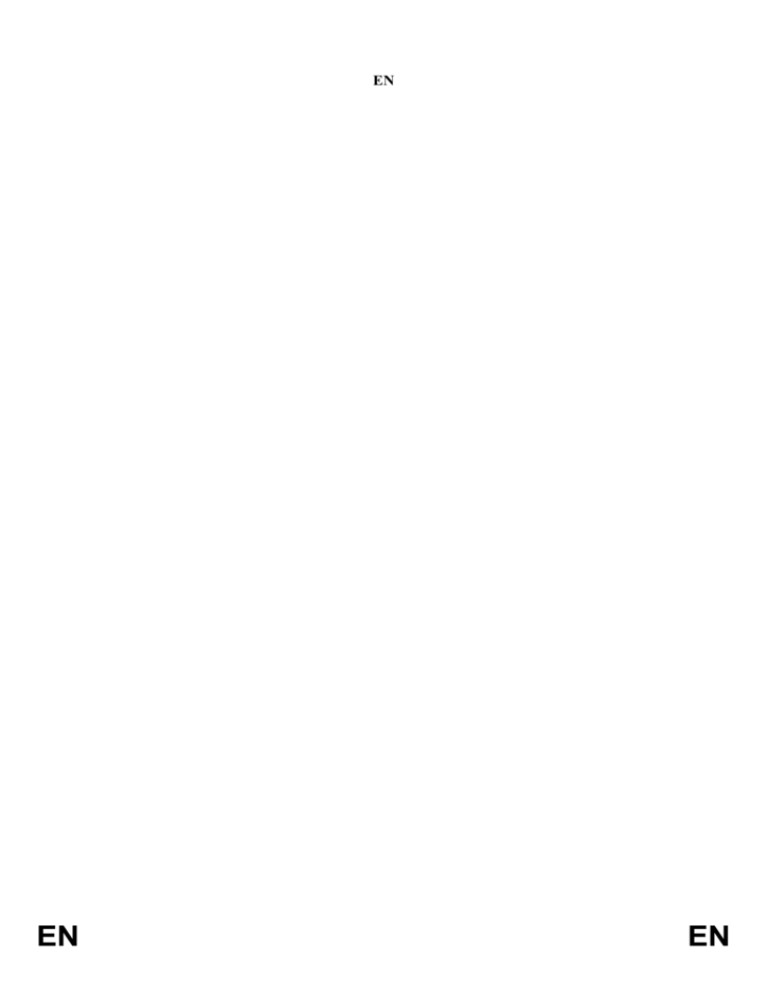
EN
EN
EN
COMMISSION OF THE EUROPEAN COMMUNITIES
Brussels, 21.12.2007
COM(2007) 843 final
COMMUNICATION FROM THE COMMISSION TO THE COUNCIL, THE
EUROPEAN PARLIAMENT, THE ECONOMIC AND SOCIAL COMMITTEE AND
THE COMMITTEE OF THE REGIONS
Towards an improved policy on industrial emissions
{COM(2007)844 final}
{SEC(2007)1679}
{SEC(2007)1682}
EN
EN
COMMUNICATION FROM THE COMMISSION TO THE COUNCIL, THE
EUROPEAN PARLIAMENT, THE ECONOMIC AND SOCIAL COMMITTEE AND
THE COMMITTEE OF THE REGIONS
Towards an improved policy on industrial emissions
1.
INTRODUCTION
Industrial activities play an important role in the economic well-being of Europe,
contributing to sustainable growth and providing high quality jobs. However,
industrial activities also have a significant impact on the environment.
The largest industrial installations account for a considerable share of total emissions
of key atmospheric pollutants (83% for sulphur dioxide (SO2), 34% for oxides of
nitrogen (NOx), 43% for dust and 55% for volatile organic compounds (VOC)). They
also have other important environmental impacts, including emissions to water and
soil, generation of waste and the use of energy.
Emissions from industrial installations have therefore been subject to EU-wide
legislation for some time. Since the 1970's various directives have been drawn up
which have ultimately led to the adoption of the following main pieces of legislation:
Directive 96/61/EC concerning integrated pollution prevention and control1
(IPPC) sets out the main principles for the permitting and control of installations
based on an integrated approach and the application of best available techniques
(BAT) which are the most effective techniques to achieve a high level of
environmental protection, taking into account the costs and benefits.
The so-called sectoral directives lay down specific provisions, including minimum
emission limit values for certain industrial activities (large combustion plants,
waste incineration, activities using organic solvent and titanium dioxide
production).
Notwithstanding minimum emission limit values set in the sectoral directives, all
industrial installations which are subject to the above pieces of legislation need to
orient their permitting regimes towards the implementation of best available
techniques.
Innovative technologies can reduce the cost for compliance with legislation on
industrial emissions. Innovation also provides opportunities for industry to benefit
from the emergence of new markets in environmental technologies. The Lisbon
Strategy identifies sustainable development and environmental protection as an
important pillar of current and future European policy and stresses the role of
environmental technologies as having “significant economic, environmental and
1
EN
OJ L 257, 10.10.1996, p. 26
2
EN
employment potential”2. Industrial emissions legislation has an active role to play in
stimulating the development and deployment of these types of technologies.
IPPC and the body of legislation on industrial emissions also have a part to play in
addressing the calls from the Member States, the European Parliament and other
stakeholders for "Better Regulation." With this in mind the Commission launched in
20053 a review of the body of legislation on industrial emissions in order to ensure its
environmental and cost-effectiveness and to encourage technological innovation.
Based on a detailed analysis of the current situation and the outcome of the review
process, the Commission proposes to streamline and enhance its policy on industrial
emissions. For the large combustion plants alone the proposals should lead to net
environmental and health benefits of at least €7–28 billion per year including the
reduction of premature deaths / years of life lost by 13,000 and 125,000 respectively.
Significant health and environmental benefits would also be achieved in other
sectors. Furthermore in collaboration with Member States the proposals would lead
to a net reduction in administrative burden by between €105 and 255 million per
year.
This Communication also includes the results of reviews prepared under Article
16(3) of the IPPC Directive4 (including a review of the Commission's Action Plan for
IPPC established in 2005, as presented in annex 1) and Article 14 of Directive
2000/76/EC on the incineration of waste5 (see annex 2).
2.
CURRENT SITUATION
The IPPC Directive required full implementation by 30 October 2007.
Approximately 52 000 installations across all Member States fall within the
Directive's remit, and by mid 2006 approximately 50 per cent of these installations
had been permitted under the IPPC Directive. Whilst further progress has been made,
it has become clear in the meantime that the efforts made were insufficient for all
Member States to comply by the Directive's deadline.
Furthermore, the Commission has carried out a detailed analysis of the quality of the
permits issued and of the permitting, compliance and enforcement regimes adopted
by Member States. Based on a two-year process of data collection through an
extensive programme of ten studies and continuous consultation of stakeholders, the
Commission has come to the conclusion that the key principles of the current IPPC
directive, in particular the integrated approach based on 'Best Available Techniques',
remain a sound basis for the future development of EU legislation on industrial
emissions.
2
3
4
5
EN
Common Actions for Growth and Employment : the Community Lisbon programme; COM(2005)330
final
COM(2005) 540final
The second reports from Member States to the Commission on the implementation of the IPPC
Directive cover the period 2003-2005. These reports were analysed in the context of an external study,
"Analysis of Member States’ second implementation reports on the IPPC Directive”, LDK-ECO
The assessment of the application of the WI Directive was included within an external study,
"Assessment of the application and possible development of Community legislation for the control of
waste incineration and co-incineration" (Ökopol, 2007)
3
EN
However, there are significant shortcomings in the implementation of the current
legislation that hinder the full exploitation of best available techniques originally
intended by the Directive, that make enforcement at Community level very difficult
and that are not conducive to the prevention or reduction of unnecessary
administrative burden.
In this context, five main areas for concern have been identified:
Insufficient implementation of BAT. The analysis showed in particular that
without further emission reduction from IPPC installations, the positive health and
environmental effects that are to be obtained from the objectives set in the
Thematic Strategy on Air Pollution will not materialise. In addition, distortion of
competition within the EU due to large differences in environmental standards is
being observed.
Limitations with regard to compliance, enforcement and environmental
improvements hinder environmental protection.
Unnecessary administrative burdens due to the complexity and inconsistency of
parts of the current legal framework.
Insufficient scope and unclear provisions of the current IPPC Directive that could
hinder the achievement of the objectives set in the Commission's Thematic
Strategies.
Constraints on the use of more flexible instruments, such as NOx and SO2
emission trading systems.
These problems were discussed and assessed in detail in the context of the
Commission's impact assessment on the IPPC review.
3.
IMPROVING LEGISLATION ON INDUSTRIAL POLLUTION AND ITS IMPLEMENTATION
In response to the obstacles encountered and described above and based on a
thorough impact assessment, the Commission is putting forward a package of
measures designed to address specific problem areas, which, over time, will lead to
an improvement of the situation.
Two key initiatives are envisaged in this context:
Revision of the current legislation on industrial emissions through simplification,
clarification and strengthening.
Reinforcement of the Commission's Action Plan on implementation.
Further to these two initiatives, the Commission will continue to work on possible
EU rules for an emission trading scheme on NOx and SO2.
EN
4
EN
3.1.
Revision of the current legislation
The impact assessment undertaken as part of this initiative has indicated that the
problems identified cannot be addressed without some changes in the legislation.
Some of the main amendments to the legislation are the following:
3.2.
(1)
Recasting the existing pieces of legislation (seven in number6) into a single
Directive on industrial emissions. This will improve clarity and coherence
both for Member States and for operators, has the potential to reduce
unnecessary administrative burdens through combined permitting and
streamlined reporting requirements, and will also achieve some
environmental benefits.
(2)
Improving and clarifying the concept of BAT to create a more coherent
application of the current IPPC directive and by requiring decisions that set
permit conditions outside BAT to be justified and documented. In addition,
current minimum emission limit values in some sectors (e.g. large
combustion plants) are tightened to ensure the progress needed for achieving
the objectives of the Thematic Strategy on Air Pollution.
(3)
Introducing minimum provisions with regard to inspection, review of permit
conditions and reporting of compliance. Incentives for eco-innovation and
support for the creation of lead markets are also considered.
(4)
Extending the scope of the IPPC Directive to cover certain activities (e.g.
combustion plants between 20 and 50 MW) and clarifying the scope for
certain sectors (e.g. waste treatment) to increase consistency and coherence of
current permitting practices.
(5)
Where the Commission is to take measures to amend non-essential elements
of the re-cast Directive, the Commission will be supported by a Comitology
Committee and will ensure broad involvement of stakeholders.
2008-2010 Action Plan on implementation of legislation on industrial emissions
With the revised legislation not entering into force for some years, the Commission
will need to ensure that Member States apply the current legislation to the fullest
extent possible. It will therefore strengthen its monitoring and supporting
mechanisms by revising and refocusing the current IPPC Action Plan on
Implementation (see assessment of progress in Annex 1) for the time period 20082010 as set out below.
Action 1. Ensure full transposition of the legislation on industrial emissions
The legislation that controls industrial emissions has been produced to protect and
improve the European environment and to protect the health and well-being of
Europe's citizens. The success of the legislation relies first of all on effective
6
EN
the IPPC Directive and Directive 1999/13/EC on solvents emissions, Directive 2000/76/EC on waste
incineration, Directive 2001/80/EC on large combustion plants and Directives 78/176/EEC,
82/883/EEC and 92/112/EEC related to the titanium dioxide industry
5
EN
transposition by Member States in their national legal systems. Several Member
States have not fully transposed the IPPC Directive and related legislation on
industrial emissions by the required deadlines. The Commission will therefore pursue
all necessary actions, including through infringement proceedings, to ensure full and
correct transposition of the legislation.
Action 2. Support Member States in cutting unnecessary administrative burdens
The Commission recognises that unnecessary and disproportionate administrative
burdens can have a real economic impact, as well as being an irritant and a
distraction for business, and it is committed to reducing the administrative burden at
EU level of existing legislation on industrial emissions. Furthermore, there are
significant opportunities to cut administrative costs at Member State level in addition
to those achieved at EU level.
To address these issues the Commission will organise an information exchange with
Member States on the establishment of specific Action Programmes on reducing
unnecessary administrative burdens at Member State level in respect of the
permitting and control of IPPC installations.
These specific Action Programmes will be based on the administrative costs
measurement exercise currently being conducted by the Commission in collaboration
with Member States as part of the Action Programme for Reducing Administrative
Burdens in the EU7.
Action 3. Support Member States in their implementation of the legislation
The Commission recognises that successful implementation of industrial emissions
legislation requires an effective exchange of information between Member States in
order to ensure consistency of approach and also to promote best practice.
The Commission will reinforce its efforts to support Member States and competent
authorities across the EU. This will include aspects of enhanced information
exchange, guidance development, visits to authorities and training. This support will
continue throughout the introduction and implementation of the revised legislation.
Action 4. Enhanced monitoring and compliance checks of the application of the
legislation on industrial emissions
The effective implementation of industrial emissions legislation requires a robust
system of monitoring and compliance checks to be in place to ensure that industry
complies with environmental requirements, as well as to reassure the public that their
health and environment are being offered the protection required.
The Commission will continue to monitor the number of IPPC permits issued and
updated and, where required, investigate the system of monitoring and inspection at
IPPC installations. Such investigation will cover specific industrial installations and
sectors, the use of general binding rules, and the analysis of complaints.
7
EN
COM(2007)23
6
EN
Action 5. Improve data collection for review of BREFs and create stronger links
with the Research Framework Programme
The permit conditions, including emission limit values (ELVs), used in IPPC permits
must be based on BAT as defined in the IPPC Directive. To help the licensing
authorities and companies to determine BAT, the Commission organises an exchange
of information between experts from the EU Member States, industry and
environmental organisations. This results in the adoption and publication by the
Commission of BAT Reference Documents (BREFs).
The review of the BREFs will continue, based on the agreed work programme and in
close cooperation with stakeholders. The guidelines established on the improved
collection of data for the BREF process will also be implemented. Furthermore, to
provide fuller information on, and support for, emerging techniques the Commission
will ensure closer links between the BREF elaboration process, the European
Research Framework Programme and the Competitiveness and Innovation
Programme.
Monitoring and review of the Action Plan
Regular reports on the implementation of the Action Plan will be published on the
internet and discussed with stakeholders. A further review of the Action Plan is
envisaged towards the end of 2010.
3.3.
Development of EU rules for an emission trading scheme on NOx and SO2
The Commission will further explore the use of IPPC-compatible, market-based
instruments such as an emission trading scheme for NOx/SO2, with a view to the
potential development of a legal instrument laying down EU-wide rules on this issue.
This will include a full analysis of options, including the scope and the allocation of
allowances, and will look into potential direct and indirect impacts for economic
sectors as well as drawing on the experience from greenhouse gas emissions trading.
4.
EXPECTED IMPACTS
The impact assessment carried out during the review process of the IPPC directive
and related legislation has assessed the impacts of the package of measures proposed.
The assessment has shown that the environmental and health benefits linked to the
proposed measures are considerable. A higher uptake of BAT, for instance, would
play a significant part in helping to close (by 30 to 70%) the existing gap between the
2020 baseline8 for SO2 and NOx and the objectives set in the Thematic Strategy on
Air Pollution leading to net environmental benefits of €7–28 billion per year for the
large combustion plant sector alone. The benefits of the proposals greatly outweigh
the economic impacts (by a factor of between 3 and 14). Furthermore, there is an
expectation of positive, but less quantifiable, impacts with regard to other Thematic
Strategies, such as those on soil, water and waste.
8
EN
Projection of Member States' implementation of current legislation
7
EN
The proposals made will make a significant contribution to the implementation of
Better Regulation and simplification of the legislation. Further, the recast of the
different pieces of legislation into a single Directive is shown to reduce net
administrative burdens by between €105-255 million per year.
No significant long term impacts on competitiveness, detrimental social impacts or
negative effects on economic growth have been identified as a result of a higher
uptake of BAT or of other improvements suggested. Rather the analysis shows that a
more unified application of BAT would help to create a more level playing field and
reduce distortion of competition within the EU in the industrial sectors covered by
the IPPC Directive. The proposals will also help to promote the development and
deployment of innovative technology.
5.
CONCLUSION
The package of policy actions outlined above and the accompanying Commission
Proposal for a new and coherent Directive on Industrial Emissions will improve the
effectiveness and efficiency of the legislation by achieving a high level of
environmental protection, reducing administrative burden and minimising distortions
of competition within the EU, without hampering the competitive position of
European industry.
EN
8
EN
Annex 1: Assessment of progress (by end 2007) in implementing the 2005 Commission's IPPC Action Plan
Description of Actions
Action 1: Ensure full transposition of the IPPC Directive
Assessment of progress
IPPC Directive correctly transposed in 12 of the EU15 Member States. Conformity
checks carried out for the EU10 and possible infringement cases to be launched.
Action 2. Enhanced monitoring of the progress made Close monitoring by the Commission of the number of permits issued or updated.
towards the full implementation of the IPPC Directive by
30 October 2007
Action 3. Compliance checks
Assessment by the Commission of the permitting and operating conditions of certain
specific installations and general binding rules. Shortcomings in implementation
identified and taken into account in the context of the IPPC review process. In addition,
several infringement cases for mis-application have been launched
Action 4. Finalisation of the first round of BREFs and start Finalization of the first round of 31 BREFs at the end of 2006; review of 7 BREFs
of their review
launched; work programme established for the review of the remaining BREFs.
Action 5. Need to clarify certain legal issues and to Publication on the internet of a detailed guidance document clarifying aspects of the
technically review the Directive
IPPC Directive based on an extensive exchange of views with Member States; guidance
on the legal and technical limitations on capacity will remain valid under the revised
Directive; several studies carried out to inform the review of the Directive.
Action 6. Assessment of ways to streamline existing Carried out as part of the IPPC review process
legislation on industrial emissions in the context of Better
Regulation
Action 7. Assessment of the use of possible market-based Carried out as part of the IPPC review process
instruments and other incentives
EN
9
EN
Annex 2: Summary report on the implementation of Directive 2000/76/EC on the
incineration of waste
Background
Directive 2000/76/EC on the incineration of waste (WID) was adopted on 4 December 2000.
Transposition into national legislation was due by 28 December 2002. From that date new
incineration and co-incineration plants have had to comply with the provisions of the
Directive. The deadline for bringing existing plants into compliance was 28 December 2005.
Under the terms of Article 14 of the Directive the Commission shall submit a report on the
implementation of the Directive to the European Parliament and the Council before the end of
2008. The first reporting from the Member States required by the Directive is due in 2009 and
will cover the period 2006-2008. Pending this reporting, collection of data and information9
has been carried out in connection with the review of the IPPC Directive and related
legislation on industrial emissions in order to ensure a close synergy between these initiatives.
This Annex summarises the main results in order to fulfil the Commission's reporting
requirement.
In the data collection exercise data on dedicated waste incinerators and cement and lime kilns
co-incinerating waste have been gathered from the respective industry organisations.
Information on other types of co-incineration plants has been gathered from the Member
States.
Number of plants and permits
It has been found that there are around 1 400 plants incinerating or co-incinerating waste in
the EU. Fewer than half of these plants (39 %) are dedicated waste incinerators. Coincineration takes place in a number of sectors, the most important being the energy sector (15
%) and the cement sector (10 %). The waste streams to/in other sectors are relatively small.
The large majority (96 %) of the plants are "existing" plants10.
Around 20 % of the installations do not yet have the required permits due by 28 December
2005. However, since this mainly concerns one Member State, it is not seen as a problem
related to the Directive itself. The overall compliance in terms of issued permits can therefore
be considered as good, and the Commission will take all the necessary actions to ensure that
all Member States comply with this requirement.
More than 90 % of the installations covered by the WID also fall under the IPPC Directive.
Only three Member States were reporting using a combined permitting strategy for the
implementation of the two directives.
9
10
EN
Assessment of the application and possible development of Community legislation for the control of
waste incineration and co-incineration (Ökopol, 2007)
Existing plants as defined in the WID are plants for which a permit existed or a permit request was
made before 28 December 2002.
10
EN
Compliance with environmental requirements
The assessment of compliance with environmental requirements has found that, in general,
incineration plants meet the air emission limit values set in the WID. In about 50 % of the
Member States either the permits contain even stricter limit values than those required by the
WID, e.g. for air emissions of dust, CO, HCl, HF, NOx, SO2 and Hg, or they include
additional requirements, e.g. relating to energy efficiency, noise abatement and accident
prevention. Only a small number of permits have been issued that include emission limit
values for parameters other than the compulsory ones, e.g. PAH, PCB or zinc.
The possibility of exemptions from certain requirements has been applied in many cases.
Around 1 000 exemptions from air emission monitoring have been granted. On the other
hand, more extensive monitoring than that required by the WID is being applied in some
Member States.
Emission control techniques
The Reference Document on the Best Available Techniques (BREF) for waste incineration
established under the IPPC Directive was published in August 2006. It states that there is
continuous development of techniques which limit costs while still maintaining or improving
environmental performance. The BREF document lists what are considered to be the best
available techniques for waste incineration, together with a number of techniques regarded as
emerging techniques and so far only demonstrated on a pilot or trial scale. In general, the
emission limit values in the WID are relatively close to the emissions that correspond to the
application of the best available techniques identified in the BREF.
Further development
The assessment of the implementation of the WID has indicated that, whilst the Directive has
brought significant improvements in the control of waste incinerators across the EU, several
issues require further action:
The measurement requirements under the WID have been highlighted as
sometimes imposing an unnecessary burden on the operators. In this respect, the
possibility for the competent authorities to grant further exemptions for certain
measurement requirements under specific conditions has been considered in the
Impact Assessment related to the review process and been included in the
proposal for a new single Directive.
The review clause of the WID specifically provides for an investigation of the
feasibility of existing cement kilns co-incinerating waste to observing the NOx
emission limit value for new cement kilns. A cost-benefit analysis is presented in
the Impact Assessment to the proposed Directive on Industrial Emissions, on the
basis of which a proposal has been put forward to apply the lower limit value to
all cement kilns co-incinerating waste. The lower limit value would also bring
consistency with the BAT associated levels presented in the BREF for the cement
and lime sector and is proposed in the new Directive.
EN
11
EN
Lastly, Member States and other stakeholders have highlighted some difficulties with the
implementation of the WID which would not necessarily require amending the Directive.
Instead these may be addressed through clarification and guidance on the interpretation and
implementation of the Directive. As part of its revised Action Plan on implementation, the
Commission will therefore take further steps to develop any necessary guidance documents in
close collaboration with Member States.
EN
12
EN
